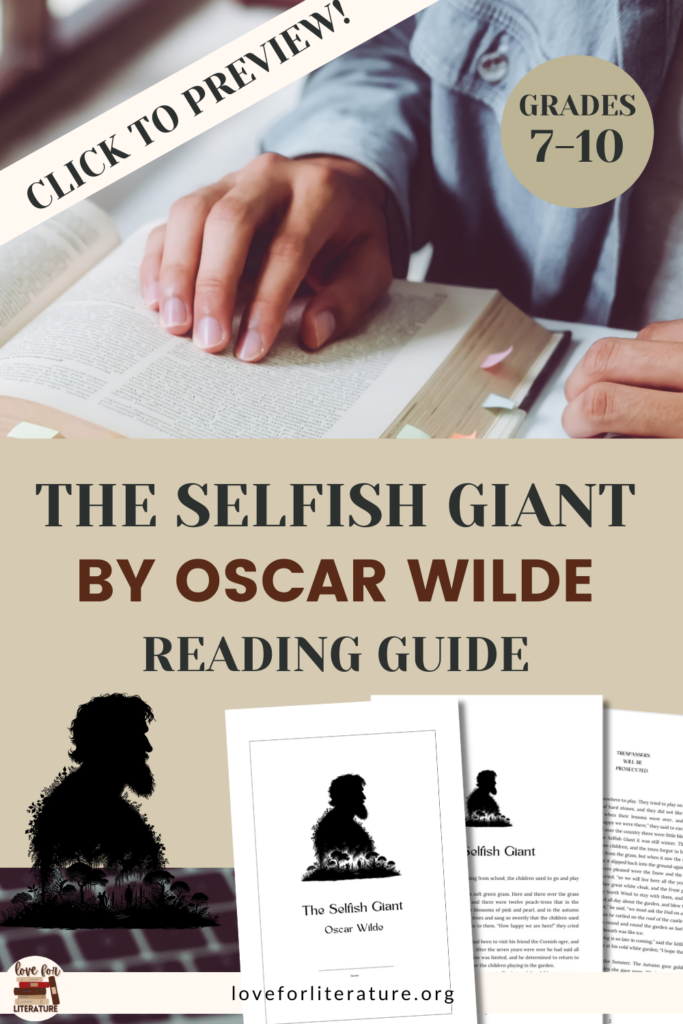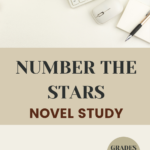There’s something enduringly beautiful about The Selfish Giant by Oscar Wilde. At first glance, it reads like a classic fairy tale. However, hidden within its lyrical prose is a profound story of transformation, grace, and the healing power of love. If you’re looking to bring this timeless tale to life in your classroom—or simply want to guide students through its deeper meaning—this reading guide is designed for you.
Thank you for reading this post, don't forget to subscribe!Whether you’re teaching middle school, exploring Christian symbolism in literature, or just need a print-and-go resource for a last-minute sub plan, this guide will meet you where you are.

✨ Key Takeaways
- The Selfish Giant by Oscar Wilde is rich with symbolism, emotion, and spiritual depth.
- This reading guide includes comprehension questions, symbolism and theme analysis, vocabulary work, and plot structure activities.
- Additionally, you’ll find ready-made lesson plans, worksheets, and answer keys that support both close reading and creative reflection.
- Altogether, it’s perfect for ELA, literature units, Christian education, or even ESL learners looking to dive into meaningful text.
🪴 Story Summary: The Selfish Giant by Oscar Wilde
The Selfish Giant by Oscar Wilde tells the story of a gruff, unkind giant who returns home after seven years to find children playing joyfully in his garden. Upset by their presence, he builds a wall to keep them out. As a result, the garden falls into a never-ending winter. Birds stop singing, trees refuse to bloom, and a cold stillness takes over.
Eventually, everything changes when the children sneak back through a small hole in the wall. The garden springs to life again—except for one snowy corner where a small boy struggles to climb a tree. Seeing this, the Giant’s heart melts. He lifts the boy into the branches, and the tree bursts into bloom. From that moment on, he opens the garden to all children, tearing down the wall that once kept them out.
Years later, the Giant grows old and weak. One winter morning, he sees the same little boy standing beneath a glowing tree, bearing mysterious wounds on his hands and feet. When the Giant asks about them, the boy replies, “These are the wounds of Love.” He then invites the Giant to his garden—Paradise. Later that day, the children find the Giant lying peacefully under the blooming tree, his soul at rest.
The Christian Meaning Behind The Selfish Giant by Oscar Wilde
At its heart, The Selfish Giant by Oscar Wilde is a parable about redemption. The garden becomes a symbol of the soul—once closed off by selfishness, but reopened through acts of compassion. The perpetual winter mirrors the spiritual coldness that comes from isolation, while the return of Spring represents renewal and grace.
Importantly, the little boy, whose hands and feet bear nail wounds, is a clear Christ figure. His appearance at the end, and his invitation to Paradise, mirrors the biblical promise of salvation. Wilde doesn’t preach—instead, he gently reveals. The Giant’s transformation is not forced but chosen, showing that love and humility can thaw even the coldest heart. Ultimately, it’s a beautiful, spiritual lesson told with childlike simplicity.
📚 What’s Inside the Reading Guide?
This resource is thoughtfully designed to guide students from surface comprehension to deeper literary analysis. It includes:
- ✅ A full printable version of The Selfish Giant by Oscar Wilde
- ✅ Reading comprehension questions that require textual evidence
- ✅ Vocabulary worksheet with space for page references and definitions
- ✅ Symbolism worksheet covering key images like the wall, winter, the garden, and the Christ-like child
- ✅ Plot structure diagram (with student worksheet + answer key)
- ✅ Theme reflection worksheet with scaffolding questions
- ✅ Three detailed lesson plans:
- Comprehension
- Symbolism
- Plot & Theme
✅ Complete answer keys for every worksheet
Altogether, it’s a flexible, plug-and-play unit that works great over a few class periods or as a deep-dive mini-unit.
💡 How to Use This Guide in the Classroom
I like to start by reading the story aloud or playing an audio version. The atmosphere shifts immediately—Wilde’s poetic language just hits differently when heard. Then, I let the students react. They’re often puzzled by the ending. Some are moved. Many ask about the boy.
From there, we explore the symbolism, talk about seasons and emotions, and slowly begin unpacking the deeper meaning. One of my favorite moments is when students realize that the wall isn’t just a wall—it’s the barrier we build when we’re afraid to be vulnerable or generous.
The theme worksheet helps connect the story to real life. In fact, students write about how the Giant changes, what the boy represents, and what the message means to them personally. The results? Always thoughtful. Often profound.
🧠 Why The Selfish Giant by Oscar Wilde Belongs in Your Curriculum
This story opens the door to meaningful conversations—not just about literature, but about kindness, empathy, and spiritual growth. It’s one of those rare tales that works on many levels. For example, younger students see a fairy tale. Older ones see a moral transformation. With the right guidance, they all see a little more of themselves.
If you’re teaching Christian students or using literature to explore faith themes, this story is a goldmine. However, even in secular classrooms, the emotional depth and literary beauty stand on their own.
📥 Ready to Dive In?
If you’re ready to bring The Selfish Giant by Oscar Wilde into your classroom in a way that’s structured, reflective, and rich in meaning, this guide is for you.
👉 Download the reading guide here
Bring Spring back to your classroom—one page at a time.


 Previous Post
Previous Post Next Post
Next Post
[…] for a short story that sparks profound reflection and symbolic exploration, I highly recommend my reading guide to The Selfish Giant by Oscar Wilde. It’s a beautiful way to weave literature, life lessons, and literary analysis […]